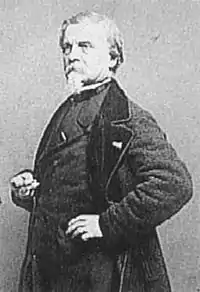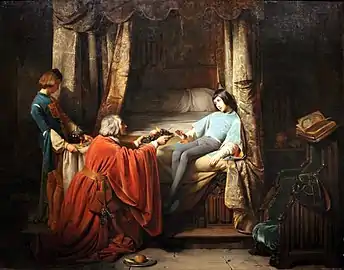Claudius Jacquand
Claude Jacquand, known as Claudius (French pronunciation: [klodjy(s) ʒakɑ̃]; 11 December 1803, Lyon – 2 April 1878, Paris) was a French painter of historical tableaus, genre scenes and religious subjects.

(date unknown)
Biography
He came from a family devoted to handicrafts and his father was a comb-maker. He had his first art lessons at the École nationale des beaux-arts de Lyon with Fleury François Richard. Following his mother's death in 1836, he moved to Paris and began exhibiting.
In 1839, he became a Knight in the Legion d'Honneur[1] and, a year later, he was awarded the Gold Medal at an exposition in Brussels. The following year, at an exhibition in The Hague, he won another Gold Medal and was decorated with the Order of Leopold. His father died shortly after, leaving him several valuable properties that enabled him to marry the aristocratic Lydia de Forbin, daughter of Louis Nicolas Philippe Auguste de Forbin and widow of the Viscount Alexandre Paul de Pinelli.[2] He taught painting to his son-in-law Auguste de Pinelli, who also became a well-known artist.[3]
He and his family settled at her hometown of Émeringes, where he built a mansion inspired by a castle he had seen in Paris. He was chosen to be Mayor in 1844.[2] A year later, he exhibited at the Salon, where Charles Baudelaire characterized him as a painter of the "twentieth quality".[4]
After the French Revolution of 1848, his income began to shrink dramatically and he sought paid employment. An effort to obtain the post of Director at the Musée de l'Histoire de France at Versailles was not successful. He and Lydia moved to Boulogne-sur-Mer in 1852 and sold their properties in Émeringes to help maintain their life style. Nevertheless, in 1856, they were forced to seek less expensive quarters in Paris. Lydia died in 1863, amid worsening financial problems. He continued to exhibit regularly, earning merely enough to get by. He died in 1878.
Selected paintings
 The Count of Comminges Recognizing Adélaide, a scene from a novel by Claudine Guérin de Tencin, 1836)
The Count of Comminges Recognizing Adélaide, a scene from a novel by Claudine Guérin de Tencin, 1836).jpg.webp) Cinq-Mars Surrendering his Épée to Louis XIII (1836–37)
Cinq-Mars Surrendering his Épée to Louis XIII (1836–37)
 Pietro Perugino Painting for the Monks of Perugia (1857)
Pietro Perugino Painting for the Monks of Perugia (1857) The Young Gaston, Called the Angel of Foix (1838)
The Young Gaston, Called the Angel of Foix (1838)
References
- Documentation @ the Base Léonore.
- Jacques du Chayard Histoire d'Émeringes Archived 2014-01-02 at the Wayback Machine, From a thesis by Dominique Richard (Cultural Advisor of the Conseil Général de Savoie)
- "Auguste de Pinelli - Un artiste une oeuvre" Archived 2014-07-02 at the Wayback Machine, Musée Mandet, Riom.
- Charles Baudelaire, "Salon de 1845", in Curiosités esthétiques. L'art romantique et autres œuvres critiques, éd. H. Lemaître, Paris, 1962 page 280 et note 156
Further reading
- Dominique Lobstein, Claudius Jacquand: les derniers moments de Christophe Colomb, Somogy Éditions d'Art 2011 ISBN 978-2-7572-048-94
- Dominique Richard, Biographie et catalogue raisonné de l’œuvre peint de Claudius Jacquand, Université Lyon II 1980